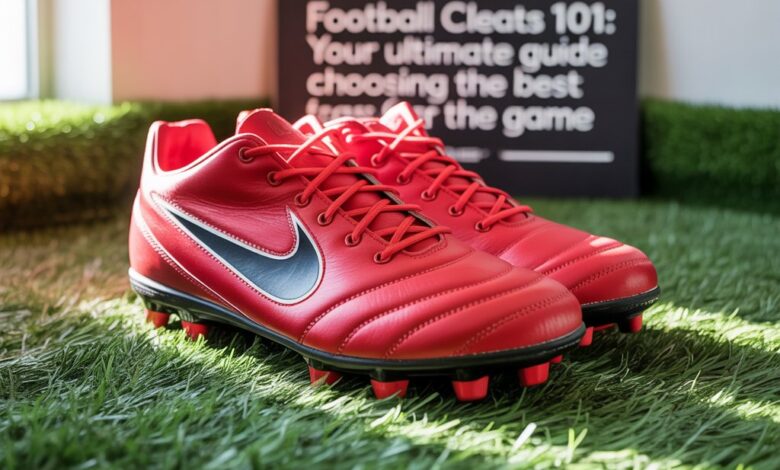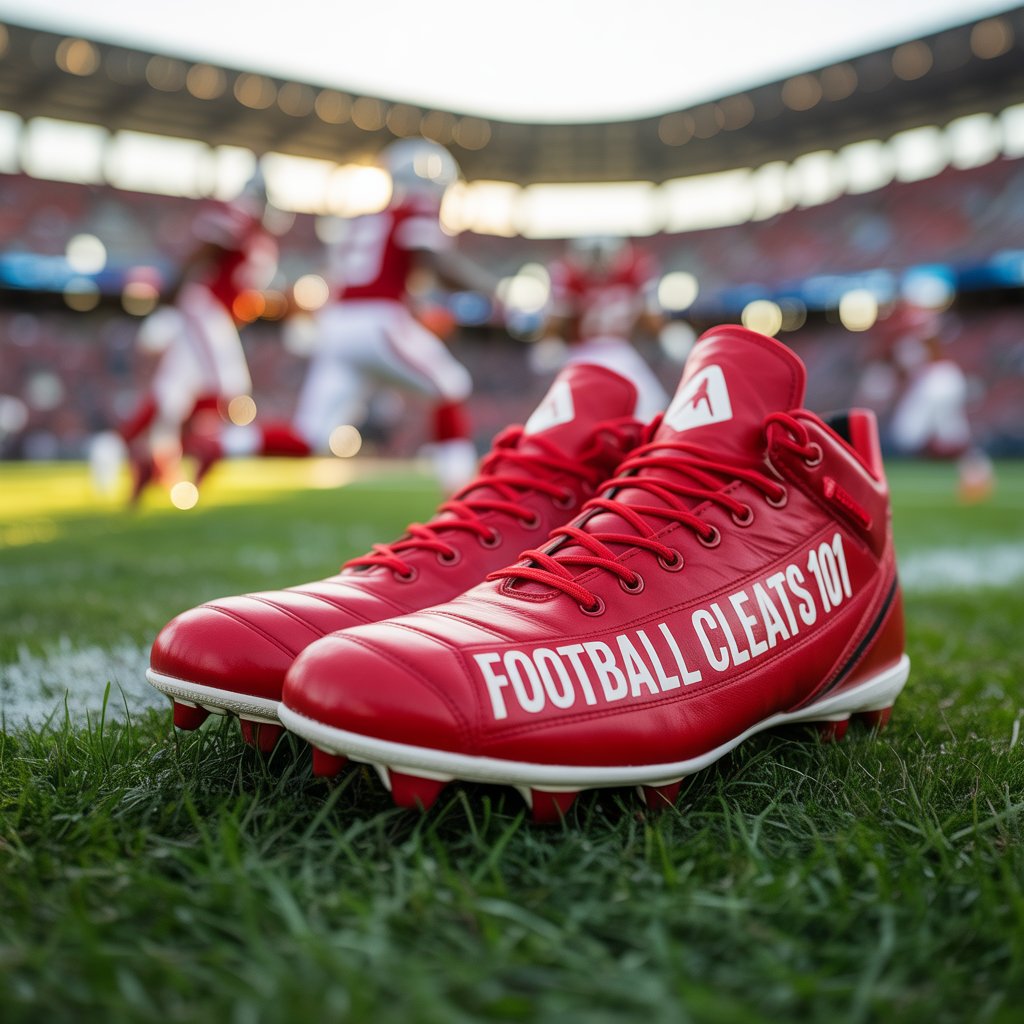Football Cleats 101: Your Ultimate Guide to Choosing the Best Pair for the Game

Introduction
Let’s face it—football is a game of speed, power, and precision. Whether you’re sprinting down the field or making a game-winning tackle, the right gear makes all the difference. One of the most important pieces of equipment? Football cleats.
You might be asking, “Aren’t all cleats the same?” Not really.
In fact, choosing the right football cleats can seriously improve your performance and help prevent injuries too. From grip on the turf to support for your ankles, cleats do more than just look cool.
In this easy-to-understand guide, you’ll learn everything you need to know about football cleats—how to choose them, what to avoid, and which ones are best for your position. Whether you’re new to the game or a proud football parent trying to help your kid out, you’re in the right place.
Let’s dive in and find your perfect pair.
What Are Football Cleats?
Football cleats are special shoes designed only for football. Unlike regular sneakers, cleats have sharp studs or spikes on the bottom. These give players traction or “grip” on grass or turf. That grip keeps players from slipping when they run, block, or change direction fast.
Football cleats also protect the feet and ankles during rough play. The shoes are often tougher and heavier than running shoes. They also come in different cuts—some cover your ankles, and some don’t.
While the design may look flashy, cleats must be strong, safe, and comfortable. They’re not meant for everyday wear, but when it’s game time, they’re a must.
Understanding what cleats do is the first step in picking the right pair. And that might just give you a winning edge.
Different Types of Football Cleats (And What They’re For)
Not all football cleats are built the same. There are three main types of football cleats, and each has a different purpose:
1. Low-cut cleats:
These are lightweight and made for speed. They stop below your ankle, so you can move fast and make quick cuts. Perfect for wide receivers, cornerbacks, and running backs who need to dash and dodge often.
2. Mid-cut cleats:
These offer a good mix of support and flexibility. They go up slightly around the ankle to help prevent injury. These are great for players who need some ankle support but still want to move fast—like linebackers and safeties.
3. High-top cleats:
These cover the ankle completely and offer the most support. Linemen and powerful players often wear these because they help keep the ankle stable.
Picking the right type depends on your position and how you play. Choosing the wrong type can hurt your speed or even cause injury.
Turf vs. Grass: What Type of Field Are You Playing On?
Cleats aren’t a one-size-fits-all thing. The type of field you play on really matters.
Grass Fields:
If you play mostly on natural grass, look for molded cleats with longer spikes. These dig into the soil and stop you from slipping.
Turf Fields:
For artificial turf, you’ll want shorter studs. Some players wear turf shoes, which have tiny rubber nubs. Others wear low-profile cleats made just for turf.
Multi-surface cleats are available too. These are made to work okay on both surfaces, but they’re not perfect for either. If you play on different fields, this might be a handy choice.
Wearing the wrong cleats for the surface can be dangerous. You could slip, twist your ankle, or just not play your best.
Position Matters: Cleats by Playing Role

Believe it or not, every football position has different needs when it comes to cleats. Let’s break it down:
Quarterbacks:
Need a comfortable shoe with control. A mid-cut cleat gives you stability while still letting you run. You need grip for quick steps and changes in direction.
Running Backs & Wide Receivers:
Go for lightweight, low-cut cleats. These let you explode off the line and make fast cuts without feeling heavy.
Linemen (offensive and defensive):
High-top cleats are best here. They support the ankle and are strong enough to handle pushing and blocking.
Linebackers & Tight Ends:
These positions need strength and speed. A sturdy mid-cut cleat often works best here.
Defensive Backs & Safeties:
Need to backpedal, turn, and sprint—low-cut cleats give you that freedom.
The right cleats for your position can truly level up your game.
Key Features to Look for in Great Football Cleats
When picking football cleats, don’t just go by looks. Let’s talk about the features that really matter:
Traction:
This is how well your cleats grip the field. More grip = better control.
Fit:
Cleats should fit snug, but not pinch. A loose cleat can lead to injuries or blisters.
Support:
Cushioning around the heel and arch can help you feel better through long practices or games.
Breathability:
Look for cleats with mesh zones or vents. Your feet will sweat less and stay cooler.
Closure System:
Laces keep shoes tight, but extra straps or velcro offer bonus support—especially for ankle protection.
Buying cleats doesn’t have to be confusing. Just focus on what helps you feel more balanced, safe, and game-ready.
Top Football Cleat Brands You Can Trust
Choosing a good brand helps ensure quality. Let’s look at some top football cleat brands trusted by players from pee-wee to the pros:
- Nike: Known for stylish design and performance. Their Vapor and Alpha Menace lines are very popular.
- Adidas: Offers lightweight cleats with cool tech like Primeknit uppers and “freak” grip.
- Under Armour: Known for durable cleats with strong ankle support and comfortable fit.
- New Balance: Less common, but making waves with comfort-forward cleats.
- Jordan: Stylish but surprisingly solid on the field—especially appealing to younger athletes.
These companies test their products with real players. That means you’re getting cleats crafted from player experience—not just fashion.
Football Cleat Sizing: How Should They Fit?
Getting the right size is super important. A bad fit can ruin your game or even cause pain.
Here are some quick sizing tips:
- Try cleats on with the same socks you’ll wear in games.
- Feet swell during play, so go cleat shopping in the afternoon if possible.
- Make sure your toes aren’t jammed. You should have a tiny bit of space.
- The heel should not slip when you walk or run.
- Never buy cleats “with room to grow.” A loose cleat is a dangerous cleat.
A great-fitting cleat should feel like part of your foot—not something you want to take off in 10 minutes.
Breaking In New Football Cleats the Right Way
Brand-new cleats can be stiff at first. Don’t worry—that’s normal!
Here’s how to break them in safely:
- Wear them at home before practice.
- Walk around your house for 10–15 minutes a day.
- Use them in non-contact drills before games.
- Don’t soak them or put them in the dryer—it can ruin the shape.
Your cleats will get softer and mold to your feet over time. This helps prevent blisters and makes you feel more confident on the field.
Cleaning and Caring for Football Cleats
Taking care of your cleats keeps them working longer. Here’s what to do:
- After games, knock off dirt or grass right away.
- Use a cloth or soft brush to scrub the surface.
- You can clean the soles with a toothbrush and soapy water.
- Don’t leave wet cleats in your bag! Air them out at home.
- Store cleats in a cool, dry place.
Good care adds life to your football cleats. And let’s be honest—clean cleats also just look better out on the field.
How Often Should You Replace Your Football Cleats?
Football cleats don’t last forever. Here’s how to know when it’s time to upgrade:
- The bottom spikes are worn down or missing.
- The shoe doesn’t fit like it used to.
- You’re feeling new pain or blisters.
- They smell bad—even after cleaning (that might mean hidden bacteria).
- The shoe has rips, bends, or flattening in the sole.
Most players replace cleats every season or two, depending on use. A well-used pair from last season might not hold up during today’s tough games.
Youth vs. Adult Football Cleats: What’s the Difference?
Youth cleats are made for growing feet. They’re usually lighter, have softer spikes, and come in more forgiving sizes. Kids’ cleats stress ease of use—some even slip on instead of tie.
Adult cleats, on the other hand, are built for full-contact play. They are tougher, with stronger shells and tighter fits. They also cost more but offer better protection.
If you’re shopping for your child, get their feet sized professionally if possible. Comfort plus support is the winning combo no matter the age.
Buying Tips: Where and When to Shop for Cleats
The best time to buy football cleats is just before the season begins. Stores usually have the newest designs and more sizes in stock.
Check out:
- Local sporting goods stores like Dick’s or Academy Sports
- Official brand websites for the latest models
- Trusted online shops like Amazon (with free returns, just in case)
Try on multiple pairs if you can! Walk, run, and pivot to feel how each pair supports your game strategy. Don’t rush the process.
FAQs
1. Can I use soccer cleats for football?
Not a good idea. Soccer cleats lack the ankle support and features football cleats provide. They’re made for different movements.
2. Are more expensive cleats always better?
Not always. Some affordable cleats work great. What matters most is fit, comfort, and field grip.
3. Can football cleats be used for other sports?
Usually not. Each sport has its own shoe needs. Football cleats aren’t great for baseball or soccer.
4. How do I know what cleats my league allows?
Always check your league’s rules. Some may prohibit metal spikes or have safety guidelines by age. Ask your coach if unsure.
5. Do cleats hurt your feet when new?
It’s normal for new cleats to feel stiff. Break them in slowly to avoid pain or blisters.
6. How can I make my cleats last longer?
Remove dirt after games, air them out, and store them properly. You can even use shoe trees to keep their shape!
Conclusion
Choosing the right football cleats is more than picking what looks cool. It’s about safety. It’s about performance. And yes—it can even be about confidence.
Whether you’re a wide receiver sprinting down the field or a lineman holding back the charge, the right cleats give you the edge. Remember to pick cleats that fit your position, your field, and your feet. Take your time, do your research, and don’t settle for “okay.”
With the right cleats, you’ll feel faster, stronger, and ready to bring your best game.
So, grab your gear, lace up tight, and get out there—because the right cleats can help turn good players into great ones.





